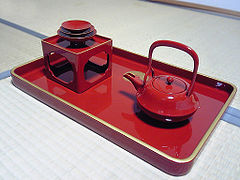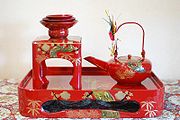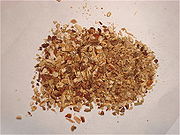
Toso
Encyclopedia

Spice
A spice is a dried seed, fruit, root, bark, or vegetative substance used in nutritionally insignificant quantities as a food additive for flavor, color, or as a preservative that kills harmful bacteria or prevents their growth. It may be used to flavour a dish or to hide other flavours...
d medicinal sake traditionally drunk during New Year celebrations in Japan
Japan
Japan is an island nation in East Asia. Located in the Pacific Ocean, it lies to the east of the Sea of Japan, China, North Korea, South Korea and Russia, stretching from the Sea of Okhotsk in the north to the East China Sea and Taiwan in the south...
.
Culture

Osechi
Osechi-ryōri are traditional Japanese New Year foods. The tradition started in the Heian Period . Osechi are easily recognizable by their special boxes called jūbako , which resemble bentō boxes...
cuisine in Japan.
Toso is written using two Japanese characters: 蘇 representing evil spirits and 屠 meaning to defeat.
Toso is made by combining several medicinal herbs to form , a spicy mixture, which is then soaked in sake or mirin
Mirin
is an essential condiment used in Japanese cuisine, consisting of 40%–50% sugar. It is a kind of rice wine similar to sake, but with a lower alcohol content—14% instead of 20%. There are three general types. The first is hon mirin , which contains alcohol. The second is shio mirin, which contains...
. If made with mirin
Mirin
is an essential condiment used in Japanese cuisine, consisting of 40%–50% sugar. It is a kind of rice wine similar to sake, but with a lower alcohol content—14% instead of 20%. There are three general types. The first is hon mirin , which contains alcohol. The second is shio mirin, which contains...
, essentially a sweet sake, it is suitable for drinking, but using fermented mirin seasoning would not be appropriate as it is too salty.
Three sizes of cup, called (see picture), are used starting with the smallest, and passed round with each family member or guest taking a sip. Drinking rituals differ by region, but in formal situations would proceed from youngest to eldest. This tradition originated in China whereby the young effectively test the drink for toxins. However, in Japan, around the beginning of the Meiji
Meiji period
The , also known as the Meiji era, is a Japanese era which extended from September 1868 through July 1912. This period represents the first half of the Empire of Japan.- Meiji Restoration and the emperor :...
or Shōwa
Showa period
The , or Shōwa era, is the period of Japanese history corresponding to the reign of the Shōwa Emperor, Hirohito, from December 25, 1926 through January 7, 1989.The Shōwa period was longer than the reign of any previous Japanese emperor...
periods, custom changed and the head of the household usually takes the first drink.
The tradition of drinking toso at the New Year began in the Tang Dynasty
Tang Dynasty
The Tang Dynasty was an imperial dynasty of China preceded by the Sui Dynasty and followed by the Five Dynasties and Ten Kingdoms Period. It was founded by the Li family, who seized power during the decline and collapse of the Sui Empire...
in China, and was adopted by Japanese aristocrats during the Heian period
Heian period
The is the last division of classical Japanese history, running from 794 to 1185. The period is named after the capital city of Heian-kyō, or modern Kyōto. It is the period in Japanese history when Buddhism, Taoism and other Chinese influences were at their height...
. The first cup drunk would be made with tososan, and the second and third cups with different varieties called byakusan and toshōsan.
The drinking ceremony finally passed to the general public and doctors would give out tososan. Even today some chemists shops have retained the custom and give tososan away as a free gift at the end of the year.
The custom is now mainly limited to Kansai
Kansai
The or the lies in the southern-central region of Japan's main island Honshū. The region includes the prefectures of Mie, Nara, Wakayama, Kyoto, Osaka, Hyōgo, and Shiga. Depending on who makes the distinction, Fukui, Tokushima and even Tottori Prefecture are also included...
and west Japan; in other regions celebratory o-toso at New Year is often plain sake without tososan.
Ingredients

Hua Tuo
Hua Tuo was an ancient Chinese physician who lived during the late Han Dynasty and Three Kingdoms era of Chinese history. The Records of Three Kingdoms and Book of Later Han record Hua as the first person in China to use anesthesia during surgery. He used a general anesthetic combining wine with a...
during the Three Kingdoms
Three Kingdoms
The Three Kingdoms period was a period in Chinese history, part of an era of disunity called the "Six Dynasties" following immediately the loss of de facto power of the Han Dynasty rulers. In a strict academic sense it refers to the period between the foundation of the state of Wei in 220 and the...
period.
Ingredients have changed somewhat over time; some of the original Chinese ones were deemed at one point or another to be too potent for casual consumption. Nowadays it is typically made from Japanese pepper
Sichuan Pepper
Sichuan pepper is the outer pod of the tiny fruit of a number of species in the genus Zanthoxylum , widely grown and consumed in Asia as a spice. Despite the name, it is not related to black pepper or to chili peppers...
, asiasari radix
Root
In vascular plants, the root is the organ of a plant that typically lies below the surface of the soil. This is not always the case, however, since a root can also be aerial or aerating . Furthermore, a stem normally occurring below ground is not exceptional either...
, apiaceae
Apiaceae
The Apiaceae , commonly known as carrot or parsley family, is a group of mostly aromatic plants with hollow stems. The family is large, with more than 3,700 species spread across 434 genera, it is the sixteenth largest family of flowering plants...
, cinnamon
Cinnamon
Cinnamon is a spice obtained from the inner bark of several trees from the genus Cinnamomum that is used in both sweet and savoury foods...
, dried ginger
Ginger
Ginger is the rhizome of the plant Zingiber officinale, consumed as a delicacy, medicine, or spice. It lends its name to its genus and family . Other notable members of this plant family are turmeric, cardamom, and galangal....
, atractylodes
Atractylodes
Atractylodes is a genus in the plant family Asteraceae.-Medicinal uses:Some species, including Atractylodes lancea and A. macrocephala , are used in traditional Chinese medicine.-Species:*Atractylodes carlinoides...
Japonica, Chinese bellflower
Chinese bellflower
Platycodon grandiflorus is a species of perennial flowering plant of the family Campanulaceae and the only member of the genus Platycodon . This species is known as platycodon or Chinese bellflower...
and rhubarb
Rhubarb
Rhubarb is a group of plants that belong to the genus Rheum in the family Polygonaceae. They are herbaceous perennial plants growing from short, thick rhizomes. They have large leaves that are somewhat triangular-shaped with long fleshy petioles...
, amongst others.
It is held to be effective medicinally and useful at the onset of colds.
Sources
- Primarily translated from the Japanese Wikipedia article as of 6 January 2007.
See also
- Japanese New YearJapanese New YearThe is one of the most important annual festivals, with its own unique customs, and has been celebrated for centuries. Due to the importance of the holiday and the preparations required, the preceding days are quite busy, particularly the day before, known as Ōmisoka.The Japanese New Year has been...
- OsechiOsechiOsechi-ryōri are traditional Japanese New Year foods. The tradition started in the Heian Period . Osechi are easily recognizable by their special boxes called jūbako , which resemble bentō boxes...
Traditional Japanese New Year fare - Sake

